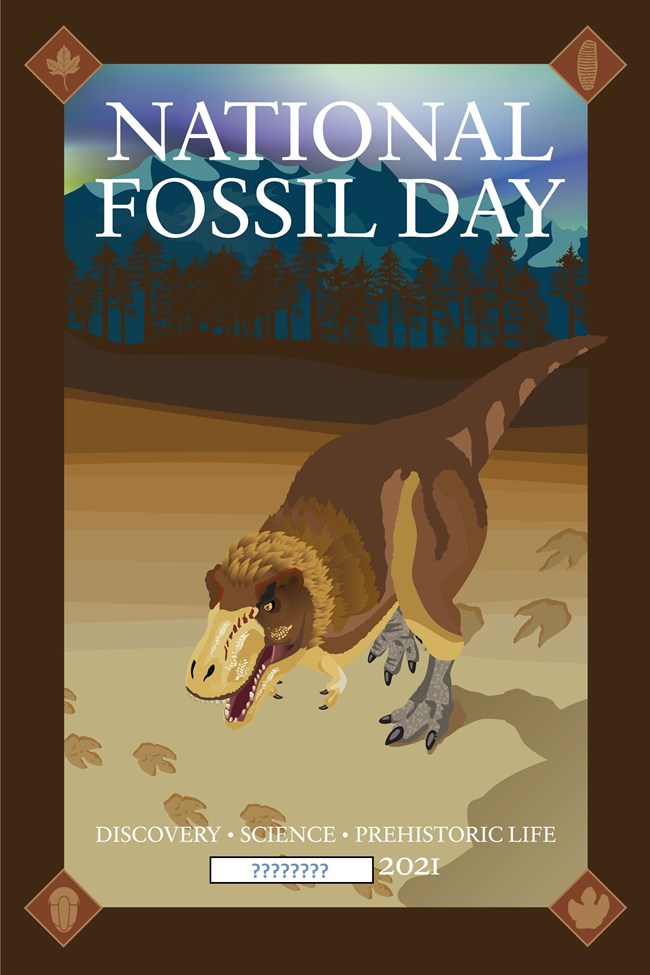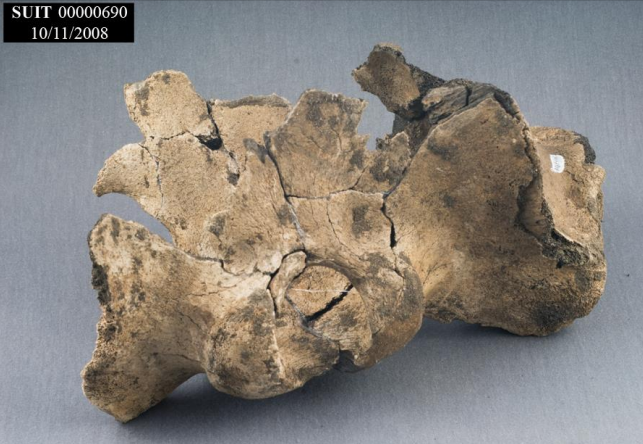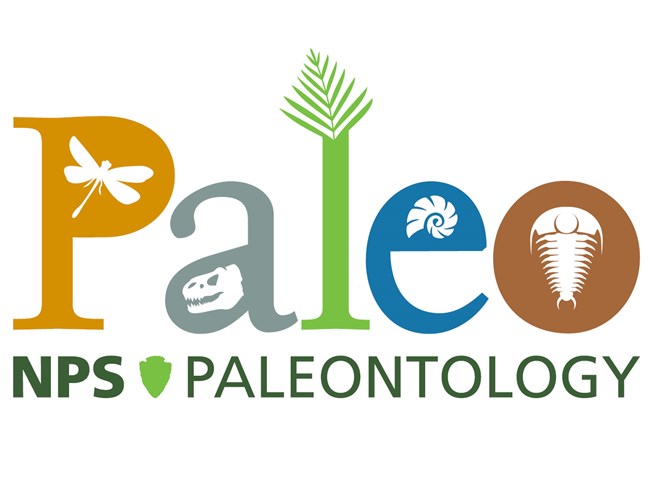Last updated: May 6, 2025
Article
The Second Great National Park Fossil Quiz
Did you know more than two-thirds of the national parks across the country have fossils in them? Test your knowledge and learn more about fossils and paleontology in national parks with this quiz. Try to answer each multiple choice question and then check to see if you "guessed" correctly using the dropdown menus. There are 10 questions. Keep track of how many answers you get correct and check your ranking at the bottom of this page.
Question 1—Ancient Footprints

At White Sands National Park, New Mexico, scientists discovered fossil footprints of both humans and extinct ice age mammals together in ancient lake deposits. What type of scientist listed below would most likely not be part of the research team to study the fossil foot prints at White Sands National Park?
a. geologist to study the lake deposits
b. archeologist to study the human footprints
c. paleontologist to study the ice age mammal footprints
d. oceanographer to study the ocean currents
d. oceanographer to study the ocean currents.
Scientists are studying these footprints to gain a better understanding of the ancient ecosystem that brought humans and ice age animals together. Learn more on the park's Fossilized Footprints webpage.
Question 2—Pygmy Fossils

Channel Islands National Park, California, preserves the fossil remains of miniature or “pygmy” forms of a prehistoric creature. Which of the following creatures are known from fossils at Channel Islands National Park?
a. pygmy dinosaurs
b. pygmy redwood trees
c. pygmy whales
d. pygmy mammoths
d. pygmy mammoths.
Featured Videos: Learn about the role of islands in the evolution of species on The Pygmy Mammoth webpage.
Question 3—Paleo Environment

Theodore Roosevelt National Park in North Dakota has fossils including leaves, petrified wood, shells of freshwater snails, fish bones, turtle shells, crocodile scutes, and bones of small mammals. What type of environment do we think Theodore Roosevelt National Park was like in the past?
a. beach along the ocean
b. forests, lakes, and rivers
c. sandy desert
d. mountain with glaciers
Question 4—Curly Clue

Look at the historic photo from Agate Fossil Beds National Monument, Nebraska. Notice the long, straight fossils and the curly Q-shaped ones. What are these fossils?
a. animal burrows
b. plant roots
c. mammoth tusks
d. dinosaurs
a. animal burrows.
Dry-land beavers called Palaeocastor dug corkscrew-shaped entryways to their burrows. This early black and white image is a part of the history of National Park paleontology—1865–1916: Early National Parks & Monuments
Question 5—Fossil Day

The 2021 National Fossil Day logo, shown to the right, features a large meat-eating dinosaur leaving footprints in mud. Which month do we celebrate National Fossil Day?
a. April
b. May
c. August
d. October
d. October.
National Fossil Day was started in 2010 and has always been on Wednesday of the first full week of October during Earth Science Week. Join us each year to Celebrate National Fossil Day!
Question 6—Dental Clue

The photo below shows the underside of a skull belonging to a prehistoric mammal known as an oreodont, Eporeodon, from John Day Fossil Beds National Monument, Oregon. The fossilized teeth have a dark brown color. What kind of food do you think oreodonts’ teeth were good for eating?
a. meat
b. plants
c. both meat and plants
d. candy
b. plants.
Oreodonts were herbivores (plant-eaters). Their teeth were used for cutting and chopping leaves. They had pig-like bodies with short legs and four hooved toes. Their large tusks were like modern pigs, but their teeth look like those of deer. Oreodonts are one of the most common fossils found at John Day Fossil Beds.
Question 7—Metro Whale

During the construction of the Washington Metro subway system, bones of a fossil whale were found along the Suitland Parkway, part of the National Capital Parks East near Washington, D.C. How did the whale get there?
a. it got lost waiting for the metro
b. it was a flying whale
c. this low-lying area was under water when the whale was alive
d. it walked to the Suitland Parkway
c. this low-lying area was under water when the whale was alive.
Easy one. However, it's interesting to note that the whale is only one of many fossils in the parks of our national capital.
Question 8—Prehistoric Parks

There are currently 423 park units in the National Park Service throughout the United States and Territories. Fossils have been discovered at how many of these park units?
a. 6
b. 25
c. 279
d. 423
c. 279.
New fossil discoveries are made in the National Parks each year, so we expect this number to continue to grow. See if your favorite parks are on the Fossil Parks List.
Question 9—St. Croix

St. Croix National Scenic Riverway in Minnesota and Wisconsin has fossils from the Cambrian, 500 million years ago, found in rocks laid down in a shallow ocean. What kinds of fossils are likely to be found at St. Croix National Scenic Riverway?
a. snails, trilobites, and worm burrows
b. dinosaurs and petrified wood
c. mammoths, horses, camels, and sloths
d. ammonites, plesiosaurs, and pterosaurs
a. snails, trilobites, and worm burrows.
These fossils are found in sea-floor sediments from the Cambrian Period—541 to 485.4 MYA. The other answers included fossils from younger-aged rocks and organisms on land. The National Park System contains rocks from each period of the geologic time scale and Fossils Throughout Geologic Time.
Question 10—Fossil Sharks!

Within Mammoth Cave National Park, Kentucky, paleontologists have recently discovered the fossil remains of primitive sharks. Since the skeleton of sharks is made of cartilage, what type of fossils do we typically find for sharks?
a. hair
b. claws
c. fins
d. teeth
d. teeth.
The soft parts of animal remains such as skin and cartilage are rarely preserved, so teeth are the most common shark fossils. Learn more about Sharks, Fossils, and Caves: Secrets Revealed at Mammoth Cave.
How did you do?
Check your ranking for the Second Great National Park Fossil Quiz:
- 9 to 10 correct answers—Ranking: Tyrannosaurus Rex (top of the food chain)
- 7 to 8 correct answers—Ranking: Quetzalcoatlus (a flying Cretaceous period predator with a 33-foot wingspan—a force on land and water, and in the air)
- 5 to 6 correct answers—Ranking: Stegosaurus (with protective plates, and measuring around 30-feet long by 14-feet tall—the Stegosaurus was steady-on)
- 3 to 4 correct answers—Ranking: Ammonite (this free-swimming mollusk is an important marker fossil common during the Mesozoic Era—Ammonites were squid-like, but with a pretty shell)
- 0 to 2 correct answers—Ranking: Fossil Sponge (some of Earth's earliest simple animals lacked a complex nervous, digestive, or circulatory system—sorry, no square pants either)
